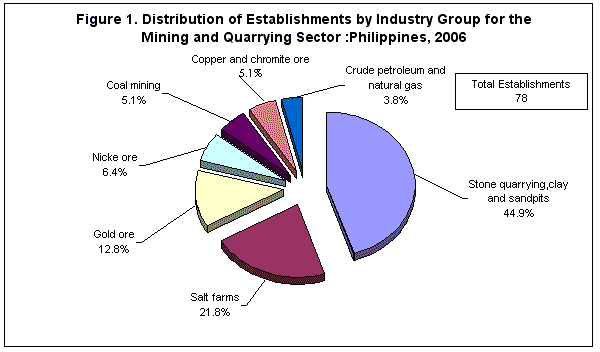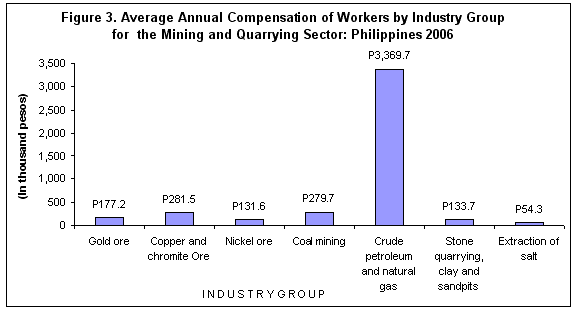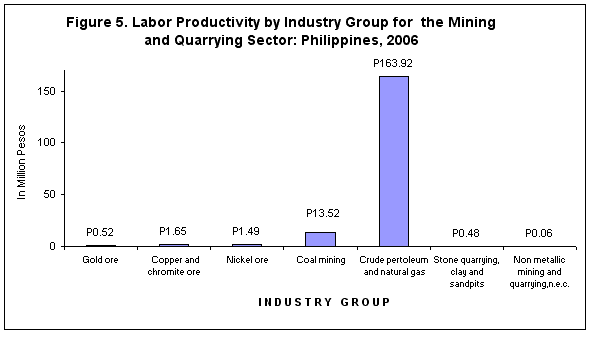Stone Quarrying Clay and Sand Pits Dominates the Mining and Quarrying Sector
- The 2006 Census of Philippine Business and Industry covered a total of 78 establishments engaged in mining and quarrying operations nationwide. Of the total, 49 or 62.8 percent were establishments with average total employment (ATE) of less than 20 and the remaining 37.2 percent were with ATE of 20 and over.
- In terms of the number of establishments, the sector was dominated by establishments engaged in stone quarrying and sand pits with 35 or 44.9 percent of the total, followed by salt farms and gold ore mines with 17 and 10 establishments, respectively.

- By size of establishment, gold ore mining dominated those with ATE of 20 and over while stone quarrying, clay and sand pits for ATE with less than 20 employees.
Nickel Ore Mining employs the biggest number of workers
- The employment generated in 2006 for all mining establishments was recorded at 10,764. Among industries, nickel ore mining provided the largest employment at 3,326 or 30.9 percent of the total, followed closely by gold ore mining with a total of 3,050 employees (28.3%).

Average annual compensation was 230 thousand pesos
- Total compensation for the sector amounted to P2.4 billion, translating to an average annual compensation of P230,120 per paid employee.
- The highest average annual compensation was earned by employees in extraction and production of crude petroleum and natural gas (P3,369,736) and the lowest in salt farms (P54,339).

Extraction and production of crude petroleum and natural gas generated the biggest output value.
- Value of output generated in 2006 by all establishments was P60.6 billion. More than half of the output value (P35.8 billion) was produced by establishments with ATE of 20 and over and P24.8 billion (40.9%) was earned by establishments with ATE less than 20.
- By industry, extraction and production of crude petroleum and natural gas accounted for the largest value of output at P31.4 billion, represnting more than half (51.8%) of the total value for the sector.

- In 2006, the value added contribution of all mining establishments was estimated at P39.3 billion. This translates to a labor productivity per employee worth P3.7 million.
- By industry, extraction and production of crude petroleum and natural gas accounted for the biggest value added at P24.9 or 63.4 percent of the total value added for the sector.

TECHNICAL NOTES
Introduction
The 2006 Census of Philippine Business and Industry (CPBI) is a comprehensive collection, compilation, evaluation and analysis of data about economic activities of the country. It will be a vital source of information for establishing benchmark levels of measurement and comparison of national, regional and provincial economic growth for the year 2006.
The field operations for the 2006 CPBI was undertaken in 2007. It covered 14 sectors of the economy:
- Agriculture, hunting and forestry
- Fishing
- Mining and quarrying
- Manufacturing
- Electricity, gas and water
- Construction
- Wholesale and retail trade, repair of motor vehicles, motorcycles and personal and household goods
- Hotels and restaurants
- Transport, storage and communications
- Financial intermediation
- Real estate, renting and business activities
- Education
- Health and social work
- Other community, social and personal service activities.
The census was undertaken by authority of five (5) legislative acts and presidential directives namely: Commonwealth Act 591, Presidential Decree 418, Executive Order No 121, Executive Order No. 352 and Executive Order No.5.
This Special Release presents the preliminary results of the census for mining and quarrying sector.The sector is composed of eight (8) industry groups, namely:
- Gold ore mining
- Copper ore mining
- Chromite ore mining
- Other metallic ore mining
- Coal mining
- Extraction and production of crude petroleum and natural gas
- Stone quarrying, clay and sand pits
- Other non-metallic mining and quarrying
2006 CPBI Design
Scope and Coverage
The unit of enumeration is the establishment. It is defined as an "economic unit under a single ownership or control, i.e. under a single legal entity, engaged in one or predominantly one kind of economic activity at a single fixed location".
The scope of the census was confined to the formal sector and it consists of the following:
- Corporations and partnership
- Cooperatives and foundations
- Single proprietorships with employment of 10 and over
- Single proprietorship with branches.
Specifically, the 2006 CPBI covers the following:
1. All establishments with Average Total Employment (ATE) 10 or more, and
2. All establishments with ATE less than 10, except those with Legal Organization (LO=1, single proprietorship) and Economic Organization (EO=1, single establishment)
that are engaged in economic activities by sectors mentioned above.
Sampling Design
For the mining and quarrying sector, all establishments were taken on a 100 percent basis.
Classification Systems
An establishment is categorized by its economic organization, legal organization, employment size, industrial classification, and geographic location.
Economic Organization
Economic Organization relates to the organizational structure or role of the establishment in the organization. The following are the types of economic organization:
- Single establishment is an one which has neither branch nor main office
- Branch only is an establishment which has a separate main office located elsewhere.
- Establishment and main office, both located in the same address and with branch/es elsewhere.
- Main office only is the unit which controls, supervises and directs one or more establishments of an enterprise.
- Ancillary unit other than Main Office is the unit that operates primarily or exclusively for a related establishment or group of related establishments or its parent establishment and provides goods or services that support but do not become part of the output of those establishments. Examples are warehouse of plants or wholesale establishments, repair shops or garage or terminals of transport establishments.
Legal Organization
The Legal Organization provides the legal basis for ownership of the establishment. The following are the types of legal organization:
- Single Proprietorship refers to a business establishment organized, owned, and managed by one person, who alone assumes the risk of the business enterprise.
- Partnership refers to an association of two or more individuals for the conduct of a business enterprise based upon an agreement or contract between or among them to contribute money, property or industry into a common fund with the intention of dividing profits among themselves.
- Government Corporation is a private corporation organized for private aim, benefit or purpose and owned and controlled by the government.
- Private Corporation is a corporation organized by private persons.
- Cooperative
Size of Establishments
The size of the establishment is determined by its average total employment (ATE). The following are the employment size classification used in the 2006 CPBI:
|
ATE |
Average Total Employment |
|
|
|
|
0 |
1-4 |
|
1 |
5-9 |
|
2 |
10-19 |
|
3 |
20-49 |
|
4 |
50-99 |
|
5 |
100-199 |
|
6 |
200-499 |
|
7 |
500-999 |
|
8 |
1000-1999 |
|
9 |
2000 and over |
Industrial Classification
The industrial classification of an economic unit is determined by the activity from which it derives its major income or revenue. The amended 1994 Philippine Standard Industrial Classification (PSIC) is utilized to classify units according to their economic activities.
The amended 1994 PSIC consists of an alpha character and 5 numeric digits. The alpha character, which represents the major division, is denoted by the characters A to Q. The first two numeric digits represent the division; the first three numeric digits, the group; the first four digits, the class; and the 5 digits, the sub-class.
Example: C - Mining and quarrying
10 - Metallic ore mining
109 - Metallic ore mining, n.e.c
1091 - Iron ore mining
10910 - Iron ore mining
Geographic Classification
The geographic or physical location of the establishments was classified in accordance with the Philippine Standard Geographic Code (PSGC) as of December 30, 2006. The PSGC contains the latest updates on the number of regions, provinces, cities, municipalities and barangays in the Philippines.
The geographic domains of the 2006 CPBI for establishments with average total employment (ATE) of 20 and over are the provinces, independent component cities, chartered cities and highly urbanized cities and municipalities. On the other hand, the geographic domains for establishments with ATE of less than 20 are the regions.
Hence, the samples of the 2006 CPBI with ATE 20 and over shall provide data for 17 administrative regions, 81 provinces, 39 cities and municipalities. For samples with ATE less than 20, the data that will be presented is limited only for regional levels.
Response
The effective response rate is 71.6 percent for the mining and quarrying sector. For establishments with ATE of 20 and over workers, the effective response rate is 87.9 percent while that for establishments with ATE of less than 20 workers it is 64.5 percent.
Concepts and Definitions
Economic activity or business is the activity of the establishment as classified under the amended 1994 Philippine Standard Industrial Classification (PSIC). Generally, the main activity of the establishment is the establishment's principal source of income. If the establishment is engaged in several activities, its main activity is that which earns the biggest income or revenue.
Employment is the number of persons who worked in or for this establishment as of November 15, 2005. The concept of employment as of the payroll November 15 was adopted for the first time in the 2002 ASPBI (reference year 2001).
Average total employment is the sum of the number of persons who worked in or for this establishment for all months of the year divided by 12, regardless of the number of months the establishment is in operation.
Paid employees are all persons working in the establishment and receiving pay, as well as those working away from the establishment paid by and under the control of the establishment. Included are all employees on sick leave, paid vacation or holiday. Excluded are consultants, home workers, workers receiving pure commissions only, and workers on indefinite leave.
Salaries and wages are payments in cash or in kind to all employees, prior to deductions for employees contributions to SSS/GSIS, withholding tax, etc. Included are total basic pay, overtime pay, and other benefits.
Value of output represents the sum of the total value of products sold, receipts from contract work and industrial services done for others, receipts from goods sold in the same condition as purchased less cost of goods sold, fixed assets produced on own account, and change in inventories of finished products and work-in-progress (ending less beginning).
Cost of materials, fuels and electricity consumed and industrial services refers to expenses incurred in the production of goods and industrial services such as materials and supplies purchased, fuels purchased, electricity purchased and industrial services done by others and change in inventory of materials, supplies and fuels (beginning less ending).
Fixed assets are physical assets expected to have productive lives of more than one year and intended for use and/or being used by the establishment. Included are land, buildings, other structures and land improvements, transport equipment, machinery and equipment, furniture, fixtures, and other fixed assets.
Book value of fixed assets is the initial value or acquisition cost of fixed assets less the accumulated depreciation.
Value added represents the sum of census value added and value of non-industrial services done for others less the cost of non-industrial services done by others and other costs.
Source: National Statistics Office
Manila, Philippines
